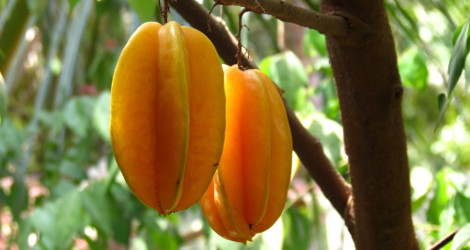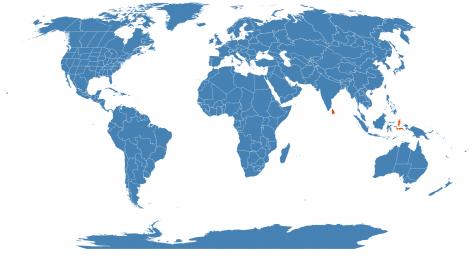Accession Data:
Averrhoa carambola L.
- Common Name: Star Fruit
- Family: Oxalidaceae R.Br.
- Description: This accession is a dwarf variety known as "Hart".
- Uses: Star-fruits are popular tropical fruits and used commonly in Ayurvedic and Traditional Chinese Medicines (TCM) in India, China, and Brazil to relieve ailments such as chronic headache, fever, cough, gastro-enteritis, diarrhea, ringworm infections, and skin inflammations 5 . Yet, this plant is very toxic due to the high amount of oxalate and caramboxin, which is a neurotoxin.
Star fruits are rich in vitamin sources. They contain many antioxidants, iron and zinc, phosphorus and magnesium. Preparations of star fruit mixtures can be used to treat fever, sore throat, headache and asthma. It has anti-inflammatory properties which aid in skin inflammation and stomach distention.
This plant however is HIGHLY toxic to people experiencing kidney problems and whom aren't able to properly filter their body. Do not take without a physician consultant and even then, be very cautious.
- IMPORTANT NOTE: Plant Uses are for informational purposes only. EEB Greenhouses assume no responsibility for adverse effects from the use of any plants referred to on this site. Always seek advice from a professional before using any plant medicinally.
- USDA Zone: 9a-11
Accession Data:
- Accession # 201500027
- Source: Top Tropicals
- Accession Date: 04-03-2015
- Bench: 3310 - NEOB: StarSteel 3x12
- Currently: active - healthy
- Qty: 1 confirmed on 07-12-2025
- Restrictions:
- Poisonous Plant Parts - Not for Human Consumption
Like several other plants of the family Oxalidaceae, its fruits are rich in oxalic acid, which is toxic in high concentrations.
- Poisonous Plant Parts - Not for Human Consumption
Classification:
- Division: Magnoliophyta
- Class: Magnoliopsida
- SubClass: eurosid I
- Order: Oxalidales
- SubOrder:
- Family: Oxalidaceae
- SubFamily:
- Tribe:
- SubTribe:
Flowering Data:
This accession has been observed in bloom on:| Year | Jan | Feb | Mar | Apr | May | Jun | Jul | Aug | Sep | Oct | Nov | Dec | ||||||||||||||||||||||||||||||||||||||||
|---|---|---|---|---|---|---|---|---|---|---|---|---|---|---|---|---|---|---|---|---|---|---|---|---|---|---|---|---|---|---|---|---|---|---|---|---|---|---|---|---|---|---|---|---|---|---|---|---|---|---|---|---|
| 2025 | ||||||||||||||||||||||||||||||||||||||||||||||||||||
| 2024 | ||||||||||||||||||||||||||||||||||||||||||||||||||||
| 2023 | ||||||||||||||||||||||||||||||||||||||||||||||||||||
| 2022 | ||||||||||||||||||||||||||||||||||||||||||||||||||||
| 2021 | ||||||||||||||||||||||||||||||||||||||||||||||||||||
| 2020 | ||||||||||||||||||||||||||||||||||||||||||||||||||||
| 2019 | ||||||||||||||||||||||||||||||||||||||||||||||||||||
| 2018 | ||||||||||||||||||||||||||||||||||||||||||||||||||||
| 2017 | ||||||||||||||||||||||||||||||||||||||||||||||||||||
| 2016 | ||||||||||||||||||||||||||||||||||||||||||||||||||||
| 2015 | ||||||||||||||||||||||||||||||||||||||||||||||||||||
References (internal):
- Medicinal Plants
- Medicinal Plants - Ayurveda Medicine
- Edible Plants
- Plants with Edible Fruits
- EEB 3271 - Systematic Botany
- Medicinal Plants - Integumentary System
- Medicinal Plants - Respiratory System
- Medicinal Plants - Urinary System
References (external):
- The Plant List (2013). Version 1.1. Last accessed on Friday, July 21, 2017.
- Morton, J. 1987. Carambola. p. 125–128. In: Fruits of warm climates. Julia F. Morton, Miami, FL. Accessed 7 April 2015.
- Averrhoa carambola at Wikipedia. Last accessed on Friday, July 21, 2017.
- Image #00 (cropped) and #04 (original) by Mailamal (Own work) [CC BY-SA 3.0], via Wikimedia Commons. Last accessed on Friday, July 21, 2017.
- Nutritional, Medicinal and Toxicological Attributes of Star-Fruits (Averrhoa carambola L.): A Review N. Muthu, Su Yin Lee, K. K. Phua, and S. Janardhan Bhore. Bioinformation. 2016; 12(12): 420–424. Published online 2016 Dec 22. Last accessed on Thursday, March 29, 2018.
data regenerated on Sat, 12 Jul 2025 11:21:04 -0400 [bcm v4.0]
Images:

Additional images for this accession:
Click on thumbnails to enlargeCurrent Accessions in the Oxalidaceae
- Averrhoa carambola



- Biophytum sensitivum



- Biophytum zenkeri

- Oxalis aff. megalorrhiza W/C
- Oxalis fruticosa



- Oxalis gigantea

- Oxalis hedysaroides 'Rubra'

- Oxalis lasiandra


- Oxalis palmifrons


- Oxalis teneriensis

- Oxalis teneriensis


- Oxalis triangularis


- Oxalis triangularis


 = indicates flowering in past 14 days
= indicates flowering in past 14 days
 = images available for this accession
= images available for this accession
 = map available for this accession
= map available for this accession
 = accession added within past 90 days
= accession added within past 90 days




